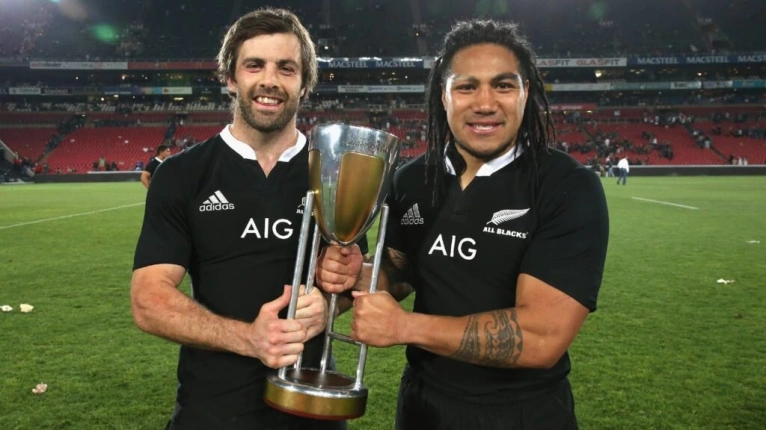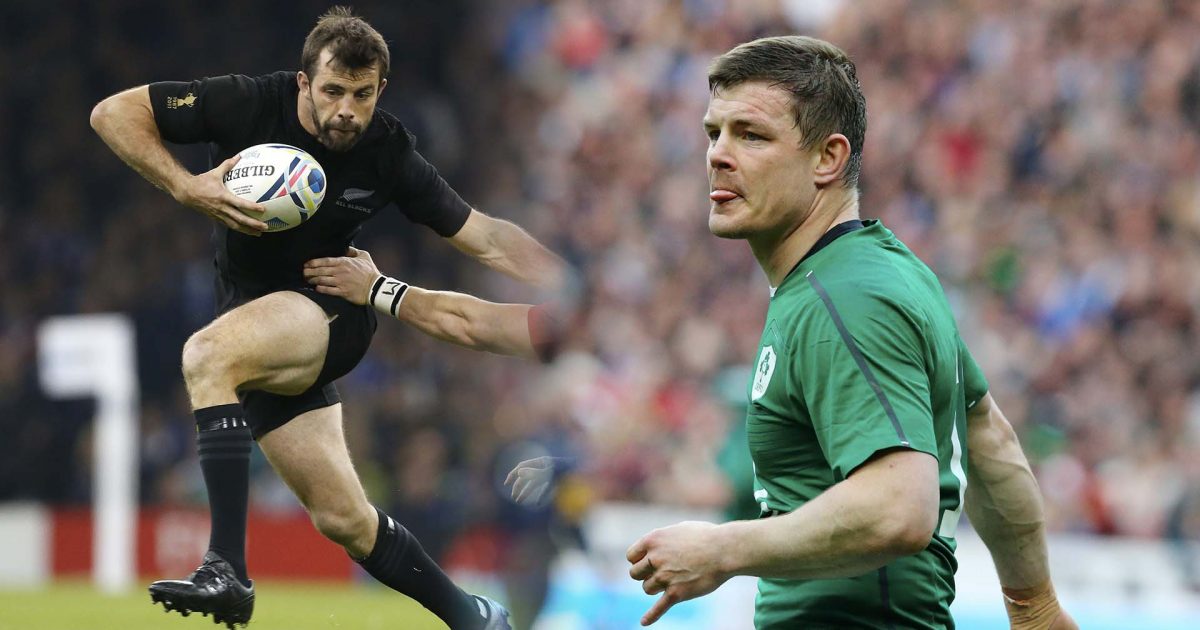Each rugby union team operates with two centres, an inside centre and an outside centre.
These players are responsible for taking on their opposite number in a head-to-head battle. If they’re successful in their quest and dominate their opposite number, a rugby outside centre can create space and try-scoring opportunities for their teammates; particularly an overlapping winger.
Due to the importance of physical contact in the role, an outside centre in rugby must be an incredibly strong and powerful player who relishes contact. However, they must also be speedy and agile, so that they can exploit gaps. On the defensive end, they must be imposing and impressive tacklers who refuse to give ground.
Think you have what it takes to excel as an outside centre in rugby? Well, read our detailed position guide to find out. Here, we talk you through the basics of the position, the responsibilities of an outside centre on the field and how elite rugby outside centres train.
What is an outside centre?
The outside centre in a game of rugby is a member of the backs. A powerful player and a quick runner, they’re responsible for breaking through defensive lines and providing space for any players outside them.
An integral part of a team’s midfield, they must work in partnership with the inside centre. They stand on the outside of their midfield partner (hence the name) and take responsibility for troubling opposition defences with their speed.
Due to their speed and power, an outside centre will create gaps for their teammates to exploit. When they take the ball, they tend to run in very direct lines. However, their ability to spot gaps makes them incredibly difficult to stop.
In defence, the rugby outside centre is a strong and dynamic tackler who must be more than willing to take contact from oncoming opponents.
Both in defence and attack, outside centres in rugby pride themselves on their ability to read the game.
Other names for an outside centre
Around the world, many rugby positions are known by different names. Although rugby fans from every rugby-playing country will know exactly what you mean if you refer to a player as the outside centre, there are some parts of the world where the outside centre is known merely as the centre.
This is because, in New Zealand, the inside centre is known as the second five-eighth. This term is used because the inside centre plays in a similar way to the fly half, who is known as the first five-eighth.
Due to this, the team only has one centre on the field. As a result, while the inside centre is known as the second five-eighth, the outside centre is known simply as the centre.
What number is an outside centre in rugby?
In a game of rugby union, each player wears a number that corresponds to their position on the pitch. This makes the sport different to others like football, where a player can wear whatever number they like.
In a game of rugby union, the outside centre will always wear the number 13 shirt. They’ll then stand next to their counterpart at inside centre, who wears the number 12 shirt.
What is the average size of an outside centre?
As we’ve mentioned, rugby outside centres need to be strong and physical players who can dominate battles. However, that said, outside centres must not become too big and heavy. This is because they need to be explosive runners who are light on their feet. Due to this, those who play at the outside centre rugby position are continually balancing their need for additional muscle while attempting to remain lean and fast.
At the elite level, the outside centre is usually slightly smaller than the inside centre. Generally speaking, outside centres are around 1.85m (6ft 1 in) tall. They usually also weigh around 95kg (15st).
Due to this, outside centres maintain a dominant and physical presence on the rugby pitch. Although they’re slightly smaller than the forwards, they are usually one of the largest backs on the pitch.
What is the outside centre’s role?
A member of the team’s midfield, whoever is playing in the outside centre rugby position must function as one of the team’s main workhorses. With responsibilities in both attack and defence, they’re an integral part of any team’s success.
On top of this, mistakes the outside centre make usually prove to be costly. This is because they operate in space and usually don’t have teammates close to them to assist them. Due to this, the outside centre must be highly skilled and cool under pressure.
What is the outside centre’s role in scrums?
The outside centre plays a limited role at scrum time. This is because the scrum is the domain of the forwards.
When the scrum forms, the outside centre stands well away from the action and simply occupies space and watches to see how the action unfolds.
If the outside centre’s team emerges with the ball, they must be ready to attack and make the most of the space available as the opposition scrambles to recover and create an effective defensive line.
When their teammates emerge from the scrum with the ball, the scrum half and the fly half will dictate the way the team attacks. If they kick, the outside centre will be charged with chasing and trying to regain possession or containing the opposition player who claims the ball.
If they pass, the outside centre must take the ball and find a gap, or start to run and pass cleverly to a player who is in space. The scrum half may also choose to run with the ball. If this is the case, the outside centre must provide support.
If the opposition emerges from the scrum with the ball, then the outside centre must be ready to defend the space around them. As part of this, they should lock their eyes on their opposite number and be prepared to engage if they make a run. However, the rugby outside centre should also believe in the ability of the players around them and hold their line. If they leave their position to tackle someone else, they’ll leave a gap the opposition can exploit.
What is the outside centre’s role in lineouts?
The outside centre’s role at the lineout is similar to their role at the scrum. They must wait to see how the play develops and then defend or attack as appropriate.
Again, the fly half and the scrum half will determine how the outside centre is involved in the play following a lineout. However, teams often run rehearsed patterns following lineouts, so if you practice properly, you will know exactly what your role involves.
What is the outside centre’s role in open play?
As with many positions on the pitch, the ability to carry the ball is key for the outside centre in rugby. One of the outside centre’s main tasks is getting over the gain line, and they must consistently find ways of beating defenders and getting the ball moving forwards. As part of this, the outside centre must be an incredibly quick player who can then capitalise on even the smallest of gaps.
On top of this, the outside centre must also be able to pass and offload the ball while running at pace. Talented outside centres are usually adept at finding space on the pitch, but once they break the gain line they must also have the ability to put their teammates into great positions to cross the try line.
So, when their team has the ball, the outside centre must be an effective ball carrier who also possesses exceptional handling skills. They must also have the speed to exploit gaps and run into space.
On the defensive side of the ball, the outside centre must continually make good decisions and read the game well. If they can do this, they can ensure they rarely become exposed in open play.
Finally, as well as continually making the right decisions, anyone playing in the outside centre rugby position must also make good one-on-one tackles. As they’re often in isolated positions, they need to both read the play and then execute the tackle in order to prevent the opposition gaining yards.
Notable outside centres

As part of our recent RugbyPass Hall of Fame fan vote, we asked our readers who they thought was the greatest outside centre of all time.
Somewhat unsurprisingly, they told us that Ireland legend Brian O’Driscoll should take the crown. He was followed in the voting by All Blacks great Conrad Smith and Springboks giant Danie Gerber.
However, although these historic players gained the most votes, several current stars of the game also garnered attention. They included England’s Manu Tuilagi and Wales star Jonathan Davies.
FAQs
Now you know the basics of playing at the outside centre rugby position. Think you have what it takes to play in this highly-skilled position? Well, read on to discover even more about the roles and responsibilities of the outside centre, including the exercises they do in the gym and tips for improving your game.
What is the difference between an outside centre vs an inside centre?
For a rugby team to play well, the inside centre and the outside centre must form an effective partnership and work cohesively. This is because the midfield pair are integral to a side’s defence. However, although they must work well together, there are a couple of major differences between the inside centre and the outside centre.
While the outside centre tends to be a hard and fast runner that can make the most of any space that appears on the pitch, the skillset of the inside centre is more similar to that of a fly half. Due to this, while the outside centre will carry the ball and make yards, the inside centre will be used as a distributor and as a kicker. That said, the outside centre must also have good hands and the ability to effectively offload the ball to a winger in space.
Overall though, the differences between the two positions aren’t huge and it is possible to play well in both centre positions at an elite level. After all, how both centres operate will depend on a coach’s game plan.
What do outside centres work on at the gym?
As we mentioned, outside centres must balance being strong and powerful with keeping their agility and speed.
If you’re looking to establish yourself as an outside centre, then you must first build a strength base in the gym. This will help you improve your throwing, sprinting and tackling. In order to do this, you should make the bulk of your exercises resistance-based. As part of this, you should try to incorporate cleans, jerks and snatches into your usual workout routine. However, it’s important to balance these exercises with a mixture of sprints and box jumps, so you can maintain your explosiveness.
On top of this, you should also look to add lean muscle mass across your body. Like many other rugby players, a lot of outside centres perform the following exercises in the gym:
- Squats
- Bench-presses
- Pull ups
- Deadlifts
- Shoulder presses
- Wood choppers
- Overhead presses
Finally, an outside centre’s work doesn’t end in the gym. After all, if you want to make it at the top level, then you also need to work on your agility and skills. So, head to the training pitch and work on improving your tackling technique, your running lines and your handling.








































































































